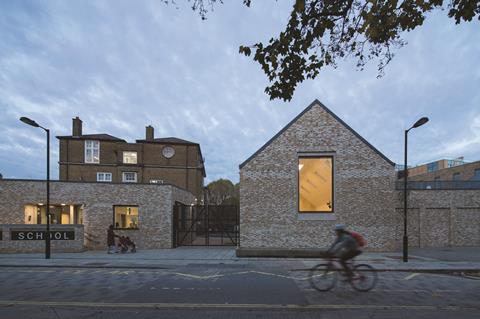- News

All the latest updates on building safety reformRegulations latest
- Focus
- Home
- News
- Focus
- Comment
- Events
- CPD
- Building the Future
- Jobs
- Data
- Subscribe
- Building Boardroom
Projects: Grange Primary School, London - top of the class
By Ike Ijeh2018-05-09T06:00:00

Maccreanor Lavington has given a tired Victorian school a public face and facilities suitable for modern teaching method, without compromising its original character or surroundings

As the new block is mostly single-storey, it does not block views of the main Victorian building
For all the good it undoubtedly did, one of the more unfortunate legacies of the quashed Building Schools for the Future (BSF) programme was its tendency to view design quality as a direct consequence of building cost. This has led to a generation of lavishly and conspicuously reconfigured school buildings where the primary focus appears to have been on big and brash new architecture – rather than an empathetic design response attuned to the needs, character, culture and fabric of the particular school building and its site.
While the subsequent drive for standardisation as evident in the successor Priority Schools Building Programme (PSBP) has certainly removed the emphasis on extravagant cost, it does not necessarily prioritise high-quality architecture either.
Which is why it is so refreshing to come across a new school that eschews both the brash exhibitionism of BSF and the dour regimentation of PSBP to devise an inspiring design solution, based on a number of modest yet highly effective design interventions. The result is a thoroughly rejuvenated school campus that applies a contemporary new face to a formerly tired and inefficient school building.
…
Already registered? Login here
To continue enjoying Building.co.uk, sign up for free guest access
Existing subscriber? LOGIN
Stay at the forefront of thought leadership with news and analysis from award-winning journalists. Enjoy company features, CEO interviews, architectural reviews, technical project know-how and the latest innovations.
- Limited access to building.co.uk
- Breaking industry news as it happens
- Breaking, daily and weekly e-newsletters
Get your free guest access SIGN UP TODAY

Subscribe now for unlimited access
Subscribe to Building today and you will benefit from:
- Unlimited access to all stories including expert analysis and comment from industry leaders
- Our league tables, cost models and economics data
- Our online archive of over 10,000 articles
- Building magazine digital editions
- Building magazine print editions
- Printed/digital supplements
Subscribe now for unlimited access.
View our subscription options and join our community


















